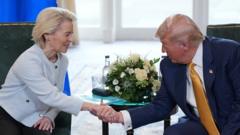The trade deal between the United States and the European Union has finally been announced, following extensive negotiations that lasted several months. During a meeting between President Donald Trump and European Commission President Ursula Von der Leyen in Scotland, both sides agreed upon a new tariff structure that will impose a 15% tariff on all European goods entering the US. This outcome is notably less severe than the 30% tariffs Trump previously threatened to implement, which would have taken effect imminently.
President Trump represented the United States, while Von der Leyen advocated for the European interests. Together, they believe that the new tariff regime will foster a more robust trading relationship between the two blocs, which together represent approximately a third of global trade.
Trump, emphasizing the significance of the deal, stated, "It's going to bring us closer together." Meanwhile, Von der Leyen proclaimed the trade agreement as a significant victory, especially after what she described as intensive negotiations.
Under the terms of this agreement, the EU is expected to invest $600 billion in the US economy, purchase substantial amounts of military equipment, and allocate $750 billion towards energy supplies. Von der Leyen noted that the investment in American liquified natural gas, alongside oil and nuclear power sources, is intended to diminish Europe's dependence on Russian energy.
While this agreement presents a compromised solution beneficial for both parties, it also encourages a flow of an estimated $90 billion in tariff revenues into the US government, acknowledging last year's trade statistics. Both nations have portrayed the agreement positively; for the EU, the tariffs are less intimidating than they could have been, while the US anticipates considerable investment influx.
Last year, trade between the US and EU reached nearly $975.9 billion, with the US importing $606 billion in goods from Europe and exporting around $370 billion, resulting in a noted trade deficit. This imbalance has been a continuing concern for Trump, who aims to restructure trade agreements to favor the American economic landscape.
Consequently, the EU prepared to impose tariffs on certain US goods as a retaliatory measure had the deal not resulted favorably. Moreover, British Prime Minister Keir Starmer is set to meet Trump at Turnberry, while Trump aims to expand family-owned golf operations in Aberdeen, showcasing his ongoing diplomatic strategy in the region.
This landmark trade deal is poised to significantly reshape the economic landscape, as both parties work toward increased cooperation and investment in the coming years.



















